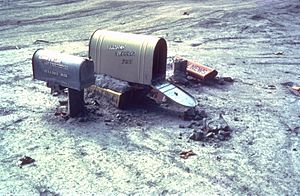Mudflow facts for kids
A mudflow or mudslide occurs when mud travels down a slope very quickly. Mudflows, which are like giant moving mud pies, happen when lots of water mixes with soil and rock. The water makes the slippery mass of mud flow quickly down. Mudflows happen most in mountainous places where a long dry season is followed by heavy rains.
Mudflows of volcanic eruptions are the most dangerous, and are called lahars. A lahar is a type of mudflow or debris flow composed of a slurry of pyroclastic material, rocky debris, and water. The material flows down from a volcano, typically along a river valley. Lahars can move as quickly as 80km/h and are as thick as liquid concrete.
Lahars have several possible causes:
- Snow and glaciers can be melted by lava or pyroclastic flows during an eruption
- A flood caused by a glacier, lake breakout, or heavy rainfall can release a lahar, also called glacier run
- Water from a crater lake, combined with volcanic material in an eruption
Lahars can occur without volcanic activity, if conditions are right for the collapse and movement of mud from existing volcanic ash deposits.
- Snow and glaciers can melt during periods of mild weather
- Earthquakes underneath or close to the volcano can shake material loose and cause it to collapse triggering a lahar avalanche.
- Rainfall or typhoons can cause slabs of solidified mud to come rushing down the slopes, with devastating results.
See also
 In Spanish: Flujo de lodo para niños
In Spanish: Flujo de lodo para niños



